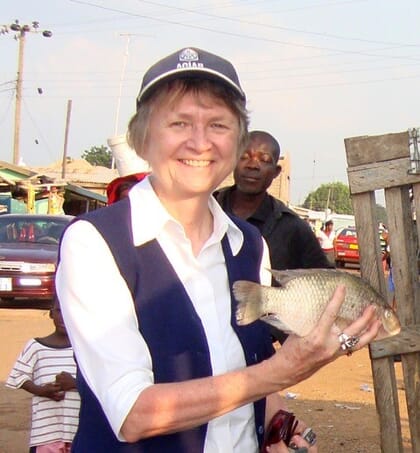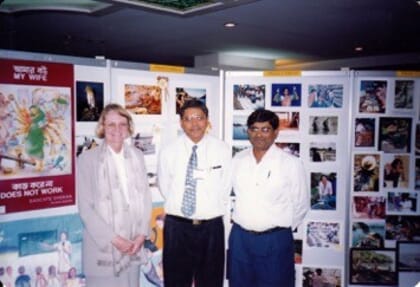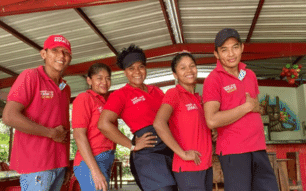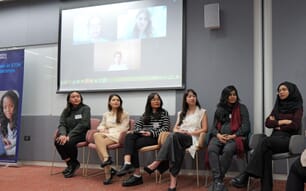Dr Meryl Williams is a key figure in Australian aquaculture, with an impressive record in research management, science and outreach in fisheries and aquaculture. In 2015 she was awarded Australia’s prestigious Crawford Fund Medal for her achievements in these areas, as well as in food security, environmental conservation, gender equality and social welfare. Prominent among these is the website Genderaquafish.org, which Williams and several colleagues established as an information exchange for gender issues that affect people working in the industry in all parts of the world. Today, she works to ensure that gender is an integral part of aquaculture policy, practice and research.

Briefly describe your aquaculture career
Aquaculture became part of my fisheries research career in the late 1980s when I was on the committee reviewing Australian marine science and we touched on the promise of mariculture. In the 1990s and 2000s I led the WorldFish Center (previously called ICLARM) and aquaculture was a major programme component. Key questions we grappled with then were how the global supply of fish could meet growing demand, how to make aquaculture inclusive of small-scale farmers, especially women, and how to create truly sustainable improvements in production from genetic improvement.
Today, I spend a great deal of time on the need for gender equality in aquaculture (and fisheries). Recently, I profiled women in aquaculture with another researcher, Dr Cecile Brugere. We concluded that, although women work in all sections of the aquaculture value chain, their opportunities have not kept pace with the booming growth. Indeed, they tend to be falling behind as enterprises intensify and scale up production, losing women who were more active in small-scale farming but have few places in larger, more mechanised, vertically integrated farming, except as cheap labour in processing factories.
What inspired you to start in aquaculture?
Aquaculture simply cannot be ignored by any fisheries professionals. Many of my fisheries colleagues felt uncomfortable about the rapid growth of aquaculture with few early safeguards to make it sustainable, and some still do. I could see that aquaculture would have a critical impact on food production and society, as did agriculture thousands of years ago, and would develop much faster than agriculture. The production figures proved this. But I am sorry to say that the enthusiasm for growth at all costs had created problems. Just as seriously, but less obviously, the failure to consider adequately the human dimensions in aquaculture is an ongoing oversight. At an aquaculture industry conference in 1998, I presented on how aquaculture could benefit the poor and found that the idea of aquaculture being a tool to help people, rather than just to make profit, was novel to most of those present. Progress has been made since then, but this has been overshadowed by the dominance of larger and larger companies, a trend that has changed the industrial organisation of aquaculture.

Describe a typical day in your current role
One of my major current undertakings is helping establish the pioneering Gender in Aquaculture and Fisheries Section, for which I have been elected the inaugural chair. Although the gender section is part of the Asian Fisheries Society, it has a global remit to promote collaboration to advance research and practice in gender equality, increase women’s visibility and encourage new networks and associations. We are building the gender section on the platform using over 20 years’ worth of women/gender in fisheries and aquaculture symposia, studies, information and action. Over the last few months, we have created the institutional machinery for our section – eg enrolled members, agreed by-laws and set priorities for partnerships and key policy positions, such as urging responsible authorities to collect better sex-disaggregated data. In October, we will also hold our first standalone global symposium, GAF-7 – Gender in Aquaculture and Fisheries: Expanding the Horizons.
I’ve also been involved in the editing of our latest publication: Engendering Security in Fisheries and Aquaculture. It contains a huge wealth of current knowledge on gender in aquaculture and fisheries from a global and Asian perspective.
What’s the most inspirational experience you’ve had working in aquaculture to date?
Most recently, I took part in the GAF-India event in Kochi, Kerala, India, held during the 11th Indian Fisheries and Aquaculture Forum. The gender presentations, mainly from South Asian countries, were very stimulating and our photo competition, in honour of the late Dr MC Nandeesha, yielded some stunning images.
How important are sustainability concerns to you and how do you address them in your work?
Sustainability is critical, but shouldn’t be addressed in isolation from the human side of aquaculture. Aquaculture and fisheries have been slow to realise this linkage. Even so, the social side – such as decent work conditions and fair and equal opportunity for women – has been taking off only slowly. Aquaculture experts, governments and investors have been much more concerned with ramping up production and meeting market standards that may address sustainability and food quality, but do little on the social side of the value chain.
Which new technical or product innovation do you think has the most potential to change aquaculture?
I could say a lot about the huge potential of smarter selection of species for domestication, the genetic improvement of a broader range of domesticated species and the promising breakthroughs in new fish-free feeds. But I want to highlight a new opportunity – we are finally seeing good progress on the complex area of how aquaculture can help bring better nutrition to people who need it, not just to wealthy consumers. The promising nutrition options include farming fish for home consumption along with others for sale, providing nutrition education to farming families and, in some locations, farming small nutrient-rich species in polyculture along with market species.

Are there any individuals or organisations in aquaculture who you’ve found particularly inspirational?
Many, but let me highlight two of them. My late colleague, Dr MC Nandeesha, was a major inspiration of all my gender in aquaculture and fisheries work. He was a true aquaculture stalwart who worked at a global scale. He worked tirelessly on raising fish production, getting small-scale farmers involved, championing the work of women, trusting and promoting farmer innovations and establishing aquaculture tertiary education for women and men. He is one of the few aquaculture luminaries honoured with a Wikipedia page.
I am also inspired by Dr Hillary Egna, leader of over 30 years of successive AquaFish programmes for development. She recognised the fundamental professional infrastructure needs for socially and environmentally sustainable development. As well as mainstream aquaculture education and research in partner countries, she directed additional efforts into stimulating more aquaculture economics, gender equality and nutrition and aquaculture studies.
Have you faced any particular challenges as a woman in aquaculture?
I came to my positions in aquaculture at a fairly senior level, and this helped. In most social and organisational hierarchies, position trumps gender, so a senior person is given respect regardless of whether a woman or a man. Education and experience also help smooth the way to acceptance for most women, but men are more likely to be accepted as credible with the equivalent experience and education. I have been continually surprised, however, by how forthright most men are in proclaiming their work achievements, whereas when a woman does this, she is considered abrasive and self-promoting.
In gender studies, these sorts of issues (different treatment according to hierarchal position, experience, education, behaviour) are called intersectionalities. In other words, we cannot simply describe a person as a woman, but must take into account many of her other characteristics that modify her experiences, image and opportunities, including in aquaculture.
How are women addressing inequalities in aquaculture in your region and have you seen the opportunities improve in recent years?
I see individual women making their own ways in aquaculture, and sometimes aquaculture news sites highlight their careers and achievements. I also see quite an upswing in the attention by researchers on women in aquaculture, when just a few years ago most of the women/gender studies in the fish sector were on fisheries.
In aquaculture education, I have seen a huge global upswing in the number of women students in aquaculture undergraduate and postgraduate courses. Colleagues and I traced this in a paper a few years ago. The big question is: are these young qualified women going to get good opportunities in aquaculture, or are their new businesses and jobs going to be thwarted by the male dominance and competitive behaviour in the sector?
Also, what I see happening recently is new networks and associations arising to promote gender equality action. Our Gender in Aquaculture and Fisheries Section is one example; the International Association of Women in the Seafood Industry is another – while some, such as the Women in Fisheries Network Fiji are geared more towards fisheries. These will put the spotlight on gender equality in the aquaculture and fisheries sectors. We need to see even more such efforts, especially local efforts representing the interests of grassroots women entrepreneurs and workers.
What advice would you give to women looking to start a career in the aquaculture sector?
In your careers, many of you will still be pioneers. Share your good luck if you have created or found a fulfilling role in the sector, and help other women to succeed. Make sure that you are conscious of ensuring gender equality in your field of influence, such as encouraging other women entrepreneurs, promoting women staff and thinking of all consumers.
What outstanding challenge would you most like to solve?
How can we motivate and incentivise those in power in aquaculture to create gender equality? From a researcher’s perspective, we are attempting to understand those social and economic realities on the ground that constrain progress, and what policies are needed to overcome the constraints. Looking at aquaculture through a gender lens really helps you see many fundamental sectoral problems that would be alleviated in a gender-equal world.





